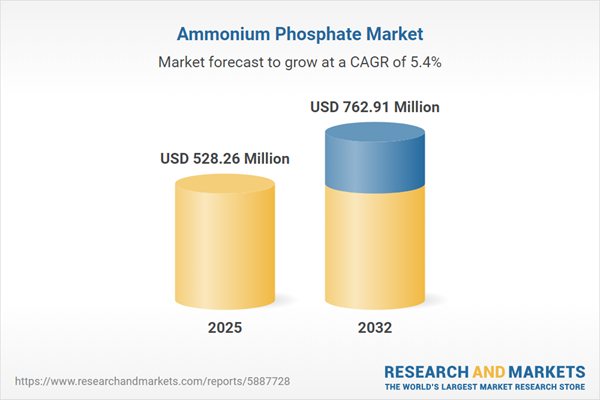Speak directly to the analyst to clarify any post sales queries you may have.
Senior executives operating in the ammonium phosphate market are responding to a landscape shaped by regulatory changes, sustainability mandates, and rapid technological progress. Aligning commercial strategies with these variables is now essential for maintaining growth and operational resilience, given the evolving expectations of both customers and regulators.
Market Snapshot: Ammonium Phosphate Market Growth and Outlook
The global ammonium phosphate market is set for steady expansion, as indicated by its strong projected growth rate and outlook. Significant demand stems from agriculture, manufacturing, and food processing sectors, with increasing applications driving the market forward. Organizations are accelerating regional initiatives and investing in new product development to safeguard and expand their presence. Market players are recognizing the importance of agile operations and robust supply chains to address changing customer requirements and comply with frequent regulatory updates. The adoption of technology and a focus on regional specificities enable sustained competitiveness and sector stability.
Scope & Segmentation of the Ammonium Phosphate Market
- Applications: Fertilizer for agricultural efficiency, feed additive for animal nutrition, metal treatment agent in manufacturing, acidulant, and emulsifier for food processing. Each application requires unique compliance and risk management frameworks.
- Grades: Agricultural-grade supports crop nutrition, food-grade targets stringent food safety and animal feed requirements, and technical-grade is used in diverse manufacturing contexts, necessitating tailored sourcing and logistical operations.
- Types: Diammonium phosphate is central to crop management strategies, while monoammonium phosphate meets specialized industrial needs, reflecting distinct regulatory and end-user influences on procurement.
- Forms: Granular, liquid, and powder formulations increase operational flexibility, supporting both automated and batch processing with adaptable transport and storage requirements.
- Regions: The Americas, Europe, Middle East, Africa, and Asia-Pacific each present specific compliance, infrastructure, and entry challenges, making market access strategies highly localized and crucial for success.
- Key Companies: Office Chérifien des Phosphates, The Mosaic Company, Nutrien Ltd., Yara International ASA, PhosAgro PJSC, EuroChem Group AG, Coromandel International Ltd., and Grupa Azoty S.A. lead the sector by integrating technology, meeting regulatory standards, and executing regionally targeted expansions.
Key Takeaways for Decision-Makers
- Enhancing sustainability measures and implementing robust product traceability systems build stakeholder trust and satisfy evolving environmental and investor expectations.
- Leveraging digital platforms, predictive analytics, and automation strengthens the ability to adapt to market changes and improves supply chain robustness.
- Pursuing high-value applications and deepening supplier collaboration raises agility in response to regulatory and market dynamics.
- Prioritizing regional procurement strategies and decentralized production models protects organizations from policy changes and logistical challenges.
- Participation in technology alliances and cross-company research initiatives drives regulatory compliance and operational innovation across the supply chain.
Tariff Impact: Implications of the 2025 U.S. Tariff Revisions
Forthcoming U.S. tariff revisions on phosphatic imports require market participants to realign sourcing and supplier strategies. Companies are increasing domestic production, diversifying supplier networks, and entering strategic agreements to maintain material availability. Reinforcing relationships across key global regions is critical for minimizing trade policy risks and ensuring continuity in supply operations.
Research Methodology & Data Sources
The insights within this report are based on interviews with senior executives from agriculture, manufacturing, and logistics. These primary inputs are reinforced through comprehensive secondary research and scenario analysis. Expert validation supports the reliability of findings, facilitating informed strategic decisions.
Why This Report Matters
- Supports procurement and operations leaders in aligning their strategies with ongoing regulatory developments and evolving market dynamics.
- Provides actionable recommendations for risk mitigation and regional expansion, enabling more effective market entry and growth strategies.
- Equips executives to lead sustainability and digital transformation initiatives, promoting organizational resilience and long-term success in the ammonium phosphate market.
Conclusion
Strengthening technology deployment, advancing sustainability measures, and diversifying suppliers position market participants to navigate ongoing industry change and achieve consistent performance despite shifting global conditions.
Additional Product Information:
- Purchase of this report includes 1 year online access with quarterly updates.
- This report can be updated on request. Please contact our Customer Experience team using the Ask a Question widget on our website.
Table of Contents
3. Executive Summary
4. Market Overview
7. Cumulative Impact of Artificial Intelligence 2025
Companies Mentioned
The companies profiled in this Ammonium Phosphate market report include:- Office Chérifien des Phosphates
- The Mosaic Company
- Nutrien Ltd
- Yara International ASA
- PhosAgro PJSC
- EuroChem Group AG
- Coromandel International Ltd
- Grupa Azoty S.A.
Table Information
| Report Attribute | Details |
|---|---|
| No. of Pages | 190 |
| Published | October 2025 |
| Forecast Period | 2025 - 2032 |
| Estimated Market Value ( USD | $ 528.26 Million |
| Forecasted Market Value ( USD | $ 762.91 Million |
| Compound Annual Growth Rate | 5.4% |
| Regions Covered | Global |
| No. of Companies Mentioned | 9 |









